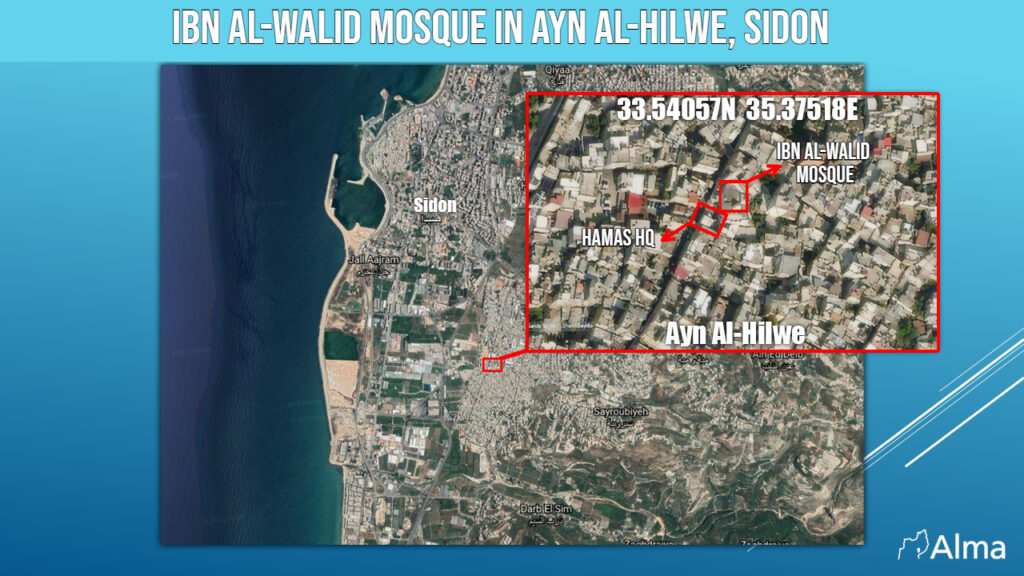On Saturday, July 29, 2023, violent clashes erupted in Lebanon’s largest Palestinian refugee camp, Ein Al-Hilwe, which is located in the suburbs of Sidon, in southern Lebanon. The clashes erupted following the assassination of Abdullah Farhud, an operative affiliated with the Islamic Fundamentalist group, in the area of the Khalid Ibn Al-Walid Mosque in the camp. Abdullah was eliminated by a Palestinian Fatah operative named Muhammad Zabidat (known as “Zumali.”) It was claimed that Zabidat acted in self-defense as part of a feud between families. It should be noted a Hamas headquarters building is located near the area of the incident, which also serves as a training center. Ein al-Hilwe serves as a central location for Hamas in Lebanon.
The Islamic Fundamentalism group is defined as a “movement of cleansing, reform and awakening” and is led by Muslims striving to return to Islamic holy texts. Its operatives believe that Muslim-majority countries must return to the foundations of religion, represented by an Islamic state, which truly illustrates the essence of the Islamic system in its political, economic and social aspects.

During the clashes, machine guns, mortars, anti-tank missiles were used, while there was also a likely use of rockets. As a result of the battle, some of the ammunition struck the region of the city of Sidon. One of the shells fell in the city’s American Square. At the same time, reports of bullets striking several neighborhoods in the city surfaced, with one hit reported in a commercial center, injuring a Syrian young man in the Dala’a neighborhood. As of this writing, reports mention six killed and tens of injured.
On Saturday evening (29 July ), the events appeared to be heading towards a lull as a result of an emergency meeting held at the Al-Nur Mosque in the camp. Representatives of the “Joint National and Islamic Forces” and the “Palestinian Executive Committee” attended the meeting. The refusal by the Fatah movement to turn in the shooter, Muhammad Ali Zabidat, led to the resumption of exchanges of fire.
During the clashes, the security officer responsible for the camp from the Fatah movement, Abu Ashraf al-Armoushi, was killed – after he attended the emergency meeting at the Al-Nur mosque. Islamic activists ambushed him and he was eliminated along with four of his security guards / escorts.

A video of the moment of Al-Armoushi’s killing:
It should be noted that the Lebanese army does not interfere in the domestic affairs of the Palestinian refugee camps in Lebanon and does not enter them. The army leaves the management of the camps’ security affairs to the factions operating within them. As events deteriorated in Ein Al-Hilwe, the Lebanese army closed the entrances to the camp and prevented traffic moving in and out of it. It should be noted that one of the mortars fired during the clashes fell in one of the military centers in the Sidon area, moderately injuring a Lebanese soldier.
The clashes that occur from time to time in Ein Al-Hilwe mostly involve groups of Islamic operatives who move with complete freedom within certain neighborhoods in the camp. These operatives are supported by money and weapons by external parties. Islamic operatives are working to reduce the role and influence of the Fatah movement externally, and internally among Palestinians. They claim that the Fatah movement is unable to achieve its goal, and is seeking to control the Ein al-Hilwe Camp in various ways, because Fatah believes it can implement the PA’s decisions outside of Palestine through the most prominent Palestinian diaspora camps, which are considered to be focal points of Palestinian activity.
The latest clashes occurred almost two months after similar clashes in the camp ended with the death of a Fatah movement. Last March, one person was killed and others were injured during similar nightly clashes in the camp.
On occasion, clashes between Fatah, which is based in the al-Baraksat area within the camp, and gunmen from other factions, based in the Safsaf neighborhood, take place. These events are not limited to specific organizations, some of which are made up of small armed groups.
More will follow…
More than 54,000 registered Palestinian refugees live in the Ein al-Hilweh camp, who are joined by thousands of Palestinians displaced from Syria as a result of the war. The camp is divided into neighborhoods, and each neighborhood has its own families, customs, traditions and armed organizations. The camp reflects Palestinian schism in all its forms, including retaliatory actions that create great tension. It is worth noting that the refugees who came to Ein al-Hilweh come from several Palestinian villages that created the basic division within it. In addition to this village-based divide, the camp is divided into security zones and old and new armed organizations, especially Islamists, such as the “Islamic fundamentalism” group.





